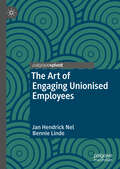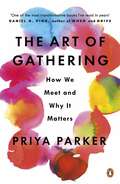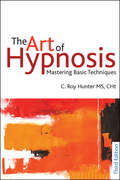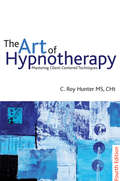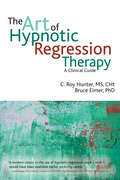- Table View
- List View
The Art of Engaging Unionised Employees
by Jan Hendrick Nel Bennie LindeThis book introduces a framework to assist human resource practitioners and organisations embrace strategies that will drive high engagement levels within organisations with a union presence. The authors address established definitions of engagement and how they have been conceptualised in academic and practitioners’ literature, before exploring and unpacking circumstances that influence levels of engagement amongst employees in a unionised environment. In doing so, the framework introduced elaborates on approaches and interventions with the greatest potential to create, improve, and embed high levels of engagement within the unionised work environment.
The Art of Forgetting
by Ivan IzquierdoHow do we forget? Why do we need to forget? This book intends to answer to these and other questions. It aims to demonstrate that each one is who it is due to their own memories. Thus, distinguish between the information we should keep from those we should forget is an difficult art. In this book, the author discusses about the different types of memory, the main types of forgetting (avoidance, extinction and repression), their brain areas and their mechanisms. In this sense, the art of forgetting, or the art of do not saturate our memory mechanisms, is something innate, that benefits us anonymously, keeping us from sinking amidst our own memories. The essays that compose this book go through several aspects, since individuals to societies' memory. By the end of the book, the reader will be able to understand that we forget to be able to think, to live and to survive.
The Art of Gathering: Create Transformative Meetings, Events and Experiences
by Priya ParkerWe spend our lives gathering - first in classrooms and then in meetings, weddings, conferences and away days. Yet so many of us spend this time in underwhelming moments that fail to engage us, inspire us, or connect us. We've all sat in meetings where people talk past each other or go through the motions and others which galvanize a team and remind everyone why they first took the job. We've been to weddings that were deeply moving and others that were run-of-the-mill and simply faded away. Why do some moments take off and others fizzle? What's the difference between the gatherings that inspire you and the ones that don't? In The Art of Gathering, Priya Parker gets to the heart of these questions and reveals how to design a transformative gathering. An expert on organizing successful gatherings whether in conference centres or her living room, Parker shows us how to create moving, magical, mind-changing experiences - even in spaces where we've come to expect little.
The Art of Grief: The Use of Expressive Arts in a Grief Support Group (Series in Death, Dying, and Bereavement)
by J. Earl RogersArt and other expressive therapies are increasingly used in grief counseling, not only among children and adolescents, but throughout the developmental spectrum. Creative activities are commonly used in group and individual psychotherapy programs, but it is only relatively recently that these expressive modalities have been employed within the context of clinical grief work in structured settings. These forms of nonverbal communication are often more natural ways to express thoughts and feelings that are difficult to discuss, particularly when it comes to issues surrounding grief and loss. Packed with pictures and instructional detail, this book includes an eight-session curriculum for use with grief support groups as well as alternative modalities of grief art therapy.
The Art of Grief: The Use of Expressive Arts in a Grief Support Group (Series in Death, Dying, and Bereavement)
by J. Earl RogersArt and other expressive therapies are increasingly used in grief counseling, not only among children and adolescents, but throughout the developmental spectrum. Creative activities are commonly used in group and individual psychotherapy programs, but it is only relatively recently that these expressive modalities have been employed within the context of clinical grief work in structured settings. These forms of nonverbal communication are often more natural ways to express thoughts and feelings that are difficult to discuss, particularly when it comes to issues surrounding grief and loss. Packed with pictures and instructional detail, this book includes an eight-session curriculum for use with grief support groups as well as alternative modalities of grief art therapy.
The Art of Group Analysis in Organisations: The Use of Intuitive and Experiential Knowledge (The New International Library of Group Analysis)
by Gerhard WilkeLeaders, teams and organisational consultants are faced with a situation of permanent transitions. The current world of organisations is full of beginnings and incomplete endings. The author assumes that the endless re-structuring of living networks of relationships in organisations generates, over time, post-traumatic stress disorder in individuals, groups and the whole system. The book deals with the paradox that continuity is the most important factor in change and that leadership alone solves very little. Even the most heroic figure flounders without the help of the various groups in the organisation, which make things work. The author reflects on his practice of developing teams, professionals and organisations with an approach rooted in group analysis and social anthropology. The dominant way of looking at performance, motivation and leadership focuses on individuals and fails to take into account how we work together, how we fail to co-operate and how inter-dependent we are.
The Art of Group Analysis in Organisations: The Use of Intuitive and Experiential Knowledge (The New International Library of Group Analysis)
by Gerhard WilkeLeaders, teams and organisational consultants are faced with a situation of permanent transitions. The current world of organisations is full of beginnings and incomplete endings. The author assumes that the endless re-structuring of living networks of relationships in organisations generates, over time, post-traumatic stress disorder in individuals, groups and the whole system. The book deals with the paradox that continuity is the most important factor in change and that leadership alone solves very little. Even the most heroic figure flounders without the help of the various groups in the organisation, which make things work. The author reflects on his practice of developing teams, professionals and organisations with an approach rooted in group analysis and social anthropology. The dominant way of looking at performance, motivation and leadership focuses on individuals and fails to take into account how we work together, how we fail to co-operate and how inter-dependent we are.
The Art of Holding in Therapy: An Essential Intervention for Postpartum Depression and Anxiety
by Karen KleimanFirst conceptualized by D.W. Winnicott, holding in this book refers to a therapist’s capacity to respond to postpartum distress in a way that facilitates an immediate and successful therapeutic alliance. Readers will learn how to contain high levels of agitation, fear, and panic in a way that cultivates trust and the early stages of connectedness. Also addressed through vignettes are personality types that make holding difficult, styles of ineffective holding, and how to modify holding techniques to accommodate the individual woman. A must-read for postpartum professionals, the techniques learned in this book will help clients achieve meaningful and enduring recovery.
The Art of Holding in Therapy: An Essential Intervention for Postpartum Depression and Anxiety
by Karen KleimanFirst conceptualized by D.W. Winnicott, holding in this book refers to a therapist’s capacity to respond to postpartum distress in a way that facilitates an immediate and successful therapeutic alliance. Readers will learn how to contain high levels of agitation, fear, and panic in a way that cultivates trust and the early stages of connectedness. Also addressed through vignettes are personality types that make holding difficult, styles of ineffective holding, and how to modify holding techniques to accommodate the individual woman. A must-read for postpartum professionals, the techniques learned in this book will help clients achieve meaningful and enduring recovery.
The Art of Hurling: Insights into Success from the Managers
by Daire WhelanHow are some hurling managers able to transform losing teams to All-Ireland champions in a short time? What is it about their philosophies and beliefs that makes them unique and successful? What are their thoughts on the future of hurling in this period of unprecedented focus on the game and its development? Daire Whelan uncovers the ideas and methods of some of the game’s most successful managers. Tracing the evolution of hurling managers from the 1970s up to the present day, he has spoken to some of the game’s most enlightened thinkers from that period, including Eamon O’Shea, Anthony Daly, Justin McCarthy, Eamonn Cregan, Babs Keating, John Allen, Cyril Farrell, Liam Griffin, Ger Loughnane, Diarmuid Healy and Terence 'Sambo' McNaughton.Managers who not only won All-Irelands or provincial titles in unique circumstances, often ending decades-long losing streaks and usually bringing success within a season or two. They provide an insight into the traits and techniques of the greatest hurling managers.
The Art of Hypnosis: Mastering Basic Techniques: Third edition (Charles Tebbetts Hypnotism Training Course Ser. #Pts. Ii & Iii)
by C. Roy HunterCrown House is pleased to announce the publication of the third edition of The Art of Hypnosis: Mastering Basic Techniques by Roy Hunter. This updated third edition includes a new introduction by Conrad Adams PhD together with a revised Chapter 1. Roy Hunter is an expert in the field of hypnosis. He was specially selected to carry on the work of the 'Grand Master of Hypnotherapy', the late Charles Tebbetts, who was a master teacher and contributor to the art/science of hypnosis and hypnotherapy. This book is based upon the training course of Tebbetts, which has been updated by Roy Hunter. Tebbetts' training has formed the basis of a large number of hypnotherapy courses taught in America and Europe. The Art of Hypnosis is well-written and easy to read and understand, even for the novice. In-depth and practical information is given on how to achieve maximum results in a hypnotic session by phrasing suggestions properly and by using various techniques to determine which approach is best for each individual client.
The Art of Hypnotherapy: Mastering Client Centered Techniques: 4th edition (Charles Tebbetts Hypnotism Training Course Ser. #Pts. Ii & Iii)
by C. Roy HunterNow in it's fourth edition, this classic text presents a comprehensive overview of client-centred hypnosis based on the teachings of Charles Tebbetts. Since the person undergoing hypnosis is the one with the power to change him/herself, the hypnotherapist acts as the facilitator, tailoring the hypnosis session to the client. All of the techniques found in The Art of Hypnotherapy, including regression therapy and parts theory, centre on this concept. The Art of Hypnotherapy shows students how all hypnotic techniques revolve around four main therapeutic objectives: Suggestion and Imagery; Discover the Cause; Release; and Subconscious Relearning. New features in this edition include an arrangement of techniques from simple to complex, so that those using hypnosis in a limited way easily learn the applicable technique; a chapter on the common application of hypnotherapy now includes new sections on anger, impotence, stuttering, and tinnitus, and the chapters on anchoring and triggers have been updated, with sections on how to help a client establish a safe place, and why this is important.
The Art of Hypnotic Regression Therapy: A clinical guide
by C. Roy Hunter Bruce EimerHypnotic Regression Therapy, or HRT, is a type of hypnotherapy in which, following the induction of a good trance state, specialized suggestions are given to guide the client in reviewing and emotionally reframing earlier experiences that have either caused or contributed to the client's current symptoms. HRT is considered one of the most valuable hypnotherapy techniques available today, yet it remains controversial, partly due to inadequate training of psychotherapists and hypnotherapists which has contributed to numerous cases of false memory syndrome.
The Art of Inspired Living: Coach Yourself with Positive Psychology
by Sarah CorrieThis book is about learning to live your life more fully. It doesn't promise you abundant joy, the relationship of your dreams, untold riches or miracle cures. But what it does promise you is a comprehensive programme of personal development, change and growth that is highly effective. This coaching programme has been developed with two audiences in mind. The first is those who wish to coach themselves to success and who are confident about achieving positive results once they know the basic framework. The second audience is those who work as coaches and who are looking for new ideas and frameworks that they can build into their existing practice. Whatever has drawn you to this book - whether it is because you feel you have reached a crossroads in your life, because you have a very specific goal in mind, or because you are a coach looking for some fresh ideas - there is something here for you.
The Art of Inspired Living: Coach Yourself with Positive Psychology (Professional Coaching Ser.)
by Sarah CorrieThis book is about learning to live your life more fully. It doesn't promise you abundant joy, the relationship of your dreams, untold riches or miracle cures. But what it does promise you is a comprehensive programme of personal development, change and growth that is highly effective. This coaching programme has been developed with two audiences in mind. The first is those who wish to coach themselves to success and who are confident about achieving positive results once they know the basic framework. The second audience is those who work as coaches and who are looking for new ideas and frameworks that they can build into their existing practice. Whatever has drawn you to this book - whether it is because you feel you have reached a crossroads in your life, because you have a very specific goal in mind, or because you are a coach looking for some fresh ideas - there is something here for you.
The Art of Interpretation: Deconstruction and New Beginnning in the Psychoanalytic Process (The International Psychoanalytical Association Psychoanalytic Ideas and Applications Series)
by Wolfgang LochThis book examines Freud's use and definition of interpretation as a therapeutic tool as well as views it from the philosophical perspective of meaning and its definition. In addition, it examines the later developments made by Klein and Bion.
The Art of Interpretation: Deconstruction and New Beginnning in the Psychoanalytic Process (The International Psychoanalytical Association Psychoanalytic Ideas and Applications Series)
by Wolfgang LochThis book examines Freud's use and definition of interpretation as a therapeutic tool as well as views it from the philosophical perspective of meaning and its definition. In addition, it examines the later developments made by Klein and Bion.
The Art of Jewish Pastoral Counseling: A Guide for All Faiths (Psyche and Soul)
by Michelle Friedman Rachel YehudaThe Art of Jewish Pastoral Counseling provides a clear, practical guide to working with congregants in a range of settings and illustrates the skills and core principles needed for effective pastoral counseling. The material is drawn from Jewish life and rabbinic pastoral counseling, but the fundamental principles in these pages apply to all faith traditions and to a wide variety of counselling relationships. Drawing on relational psychodynamic ideas but writing in a very accessible style, Friedman and Yehuda cover when, how and why counseling may be sought, how to set up sessions, conduct the work in those sessions and deal with difficult situations, maintain confidentiality, conduct groupwork and approach traumatic and emotive subjects. They guide the reader through the foundational principles and topics of pastoral counseling and illustrate the journey with accessible and lively vignettes. By using real life examples accompanied by guided questions, the authors help readers to learn practical techniques as well as gain greater self-awareness of their own strengths and vulnerabilities. With a host of examples from pastoral and clinical experience, this book will be invaluable to anyone offering counselling to both the Jewish community and those of other faiths. The Art of Jewish Pastoral Counseling will appeal to psychoanalysts, particularly those working with Jewish clients, counselors, psychotherapists, psychoanalysts and rabbis offering pastoral counseling, as well as clergy of other faiths such as ministers, priests, imams and lay chaplains.
The Art of Jewish Pastoral Counseling: A Guide for All Faiths (Psyche and Soul)
by Michelle Friedman Rachel YehudaThe Art of Jewish Pastoral Counseling provides a clear, practical guide to working with congregants in a range of settings and illustrates the skills and core principles needed for effective pastoral counseling. The material is drawn from Jewish life and rabbinic pastoral counseling, but the fundamental principles in these pages apply to all faith traditions and to a wide variety of counselling relationships. Drawing on relational psychodynamic ideas but writing in a very accessible style, Friedman and Yehuda cover when, how and why counseling may be sought, how to set up sessions, conduct the work in those sessions and deal with difficult situations, maintain confidentiality, conduct groupwork and approach traumatic and emotive subjects. They guide the reader through the foundational principles and topics of pastoral counseling and illustrate the journey with accessible and lively vignettes. By using real life examples accompanied by guided questions, the authors help readers to learn practical techniques as well as gain greater self-awareness of their own strengths and vulnerabilities. With a host of examples from pastoral and clinical experience, this book will be invaluable to anyone offering counselling to both the Jewish community and those of other faiths. The Art of Jewish Pastoral Counseling will appeal to psychoanalysts, particularly those working with Jewish clients, counselors, psychotherapists, psychoanalysts and rabbis offering pastoral counseling, as well as clergy of other faiths such as ministers, priests, imams and lay chaplains.
Art-of-Living: A Concept to Enhance Happiness (Social Indicators Research Series #63)
by Bernhard SchmitzThis volume examines the questions of what constitutes a good life and how one can achieve happiness and well-being, and analyses different ways in which people can strive for a good life. First, it presents an overview on important concepts in psychology that are related to living a good life. Then, a new approach is introduced: the concept of art-of-living as a holistic way to reach happiness. Empirical studies are reported involving a questionnaire for measuring art-of-living, and the validity of the questionnaire is demonstrated with respect to a wide range of concepts. In addition, the volume provides results from empirical studies, showing that, and how, art-of-living and happiness can be enhanced. Several intervention studies are described in detail, which have been performed with different groups of subjects, including pupils, university students and employees. Also, results of interviews are summarized, which were held with people who had been nominated as exemplary artists-of-living. The volume concludes with a description of art-of-living in autobiographies, and presents suggestions for further research with respect to art-of-living.
Art of Living, Art of Dying: Spiritual Care for a Good Death
by Carlo LegetTalking about dying and death can be difficult for those facing the end of life. This book presents a model and offers examples for discussing existential questions with patients receiving end-of-life care. Updating the Ars Moriendi tradition, this book offers a non-judgemental approach for supporting people through the spiritual aspects of dying.
The Art of Living Sideways: Skateboarding, Peace and Elicitive Conflict Transformation (Masters of Peace)
by Sophie FriedelSophie Friedel explores the action of skateboarding in her book as a way to escape cycles of despair, not only in war torn environments and regions affected by poverty. The author critically reflects on her involvements of teaching skateboarding in Afghanistan within the context of youth empowerment and peace work. By way of personal experiences, Friedel illustrates how skateboarding can be understood as an elicitive approach to peace work and conflict transformation that unfolds the extraordinary human potential inherent to all of us.
The Art Of Loving (PDF)
by Erich FrommSince it was first published " The Art of Loving" has become a classic, inspiring thousands of people with its clarity and power. Erich Fromm, the renowned psychoanalyst, sees love as the ultimate need and desire of all human beings. In this book, he discusses every aspect of the subject: romantic love, the love of parents for children, brotherly love, erotic love, self-love and the love of God or the divine. He looks at the theory of love as it appears throughout the cultures of the world and at the practice, how we show or fail to show love to one another. Love is an art, which we need to develop and practice in order to find true commitment. We need to find it, individually and as a society as a whole. Erich Fromm is one of the major figures in the field of psychoanalysis. He devoted himself to consultant psychology and theoretical investigation for many years. He was the author of numerous books, including " Fear of Freedom" and "Psychoanalysis and Zen", before his death in 1980.
The Art of Making Children: The New World of Assisted Reproductive Technology
by Francois AnsermetThis book explores the issues that surround medically assisted reproduction by addressing them from the perspective of four key areas: the mystery of procreation and the enigma of origin and where we come from; the question of difference and alterity in procreation (be it the breaking down of the notion that one comes from two in heterologous procreation to the aspirations for same-sex procreation, or the blurring of chronology and generations through cryoconservation); the place of destiny, including how to think about individual destinies in an age of increasingly accessible gene sequencing paired with a growing link between procreation and prediction; and an exploration of how clinicians and professionals can respond to the subjective experiences of those who resort to medically assisted reproduction, and the singularity of each person's response to the difficult and complex questions it raises.
The Art of Memory
by Frances A. YatesOne of Modern Library's 100 Best Nonfiction Books of the Twentieth Century In this classic study of how people learned to retain vast stores of knowledge before the invention of the printed page, Frances A. Yates traces the art of memory from its treatment by Greek orators, through its Gothic transformations in the Middle Ages, to the occult forms it took in the Renaissance, and finally to its use in the seventeenth century. This book, the first to relate the art of memory to the history of culture as a whole, was revolutionary when it first appeared and continues to mesmerize readers with its lucid and revelatory insights.
